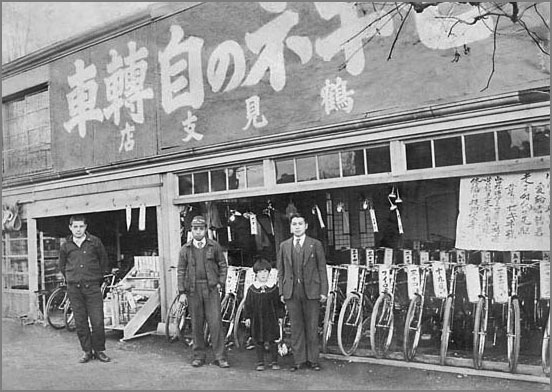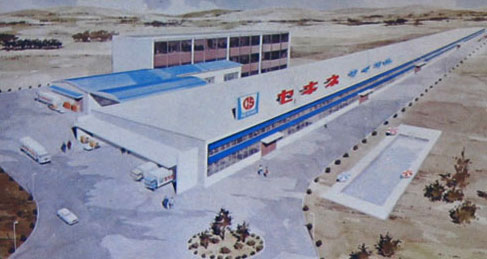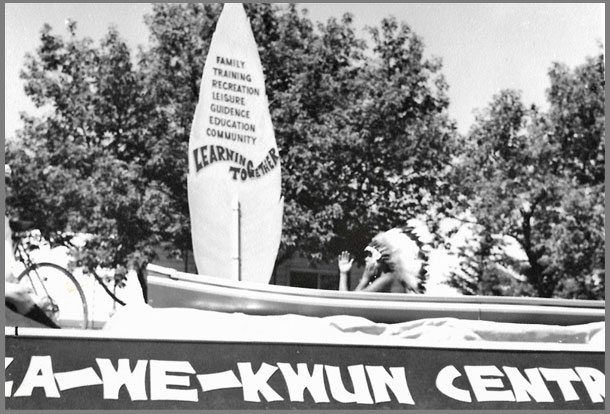

|
|

|
Part
1: Beginnings


For about a
decade, beginning in 1973, thousands of high-quality Sekine bicycles
were manufactured near Rivers, Manitoba at the Oo-za-we-Kwun Centre in
facilities that were once part of one of the most important Air Force
Bases in Canada.
The story of the Sekine Bicycle Company in Canada is a story that
brings together many threads of the larger history of our community,
our nation, and our trade relationships with the outside world. Japan
was not a notable trading partner in the early part of the 20th
century, and as the decades progressed it became our enemy in the
Second World War. So the creation of the Sekine Corporation in
Japan had little impact internationally.
Chuzo Sekine from Tokyo began manufacturing bicycles in Arakawa in
1912. It was a small enterprise in Japan’s domestic market for some
time and little detail is available about its operations. We do know
that in 1950 the Sekine Company received a Japanese Trade Industry
Award and that in 1962 they passed an industrial standards
examination.
The city of Arakawa was a working class, industrial community and the
original Sekine’s were designed for practical transportation. Cars were
not common and bikes were used for getting to work and running
errands. The early Sekine’s often had very large baskets or bins
attached. This was long before biking became primarily a recreational
activity.
Winnipeg filmmaker Derek Eidse interviewed Michio Kimura, who used to
be the head engineer for Sekine Canada, as well as the assistant to the
President of Sekine Canada. He knew the original Mr. Sekine from
Arakawa, Japan.
He was known as a very humble man, and it was said of him that, “The
lower he bowed, the more money he made.” As a businessman he had
an eye for detail and quality, and would regularly send raw materials
back to suppliers if it didn’t meet his approval.
The product evolved with the times. Bikes made in the 50’s were far
from glamorous. They were heavy dependable vehicles, built to last. But
they also had distinctive detailing that carried over into the modern
era when bikes became more about recreation than about mere
transportation.
In 1968, Sekine’s new factory in Saitama Prefecture was the most modern
bicycle production facility in Japan. In 1969, the product was selected
as, “the best designed bicycle by the Ministry of International Trade
and Industry in Japan.

A bicycle shop in Japan – practical
transportation for working people.
After
the Second World War, however, Japan slowly became more economically
connected to the west. For some time “Made in Japan” was
synonymous with low cost and many of its industries focused on mass
production of inexpensive consumer goods. Low wages and other costs
gave it an advantage over North American and European producers. This
began to turn around in the camera and electronics industries in the
1950s, a trend that continues to this day when Japanese manufactured
goods, from cars to guitars, are known for quality and workmanship.
As the 1970s opened, the U.S. market for adult bicycles was basically
owned by the French and English. While Japanese bicycles were
manufactured to very tight tolerances, and nicely finished
(considerably better than their European competition), the Japanese had
not yet come to terms with the average American's being taller and
heavier than the average Japanese. (This gap was wider at the time than
it is now, due to the privations the Japanese population suffered
during and after the war.)
 This
plant, built in 1968 in Tokyo, Japan produces the Japanese – made
Sekines
This
plant, built in 1968 in Tokyo, Japan produces the Japanese – made
Sekines
Just as Sekine began developing models that would attract buyers in the
American / Canadian market, the market itself expanded. Biking was no
longer just for kids. Fitness was becoming fashionable, and
recreational bike use was taking off. The economy was strong, wages
were increasing, and people had both the leisure and the resources to
pursue more recreational activities. Amongst the dedicated cyclists a
quality bike was a necessity, and a status symbol. The Sekine became
the BMW of the youthful, fitness conscious urban professional.
That change in lifestyles along with the general growth of
international trade spelled success for Sekine. What had started as a
small but successful business supplying the local market, was now
becoming an international player in an expanding field.
By the early seventies, both Canada and the United States began
importing bicycles from Europe and Japan, and the demand kept growing.
About that time the Canadian government, feeling pressure from a major
domestic bicycle manufacturer who happened to have a bit of a strangle
hold on the Canadian bicycle market at the time, elected to impose an
import tariff on bicycles coming into the country. This was a
standard economic tactic in that era when countries tried to protect
their industries by making the price of imports artificially higher.
What we now call globalization was about to change all of that, but for
a time the strategy was successful in keeping jobs at home.
In this case, however, the tariff did not apply to bicycle parts, just
complete bicycles. With this loophole in mind, foreign companies,
such as Raleigh, Peugeot and Sekine set up shop on Canadian soil.
Sekine lead the way and was soon exploring options that would allow it
to manufacture in Canada and thus circumvent the tariff, while still
using Japanese-made parts. It was seen as a win-win. Sekine capitalized
on the expanding market with increased production of parts, Canada got
the jobs and other associated benefits of assembling those parts
here.
The pieces of the puzzle were coming together – the increased design
expertise at Sekine headquarters, the growing popularity of cycling,
and the need to be competitive in a foreign land.
At the same time (1969) the Canadian Government began to focus on a
proactive approach to the economy of Canadian manufacturing. DREE, the
Department of Regional Economic Expansion was created to spur growth in
regions that required it. Grants and loan guarantees were the tools it
would use to promote industry
Timing is everything, and there was one more component needed.
In 1973 it just so happened that the recently closed Canadian Forces
base near Rivers Manitoba, was home to the Oo-Za.We-Kwun Centre, a
project with a twofold purpose. Its mission was to provide industrial
training for Aboriginal Manitobans while providing a new lease on life
for the recently abandoned base with its wide variety of
infrastructure. So, right here in Rivers Manitoba, we had both a supply
of workers and a ready infrastructure for a manufacturing enterprise.

The Oo-Za.We-Kwun (Yellow Quill) display at a parade in Rivers – mid
70’s
So it was that an Asian business giant would partner up with the
Canadian government and a First Nation business group, to use that
available space to create and market the Canadian made Sekine bicycle.
|
|